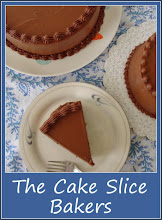 This months challenge was selected by Morven of Food Art And Random Thoughts. She selected a lemon scented white cake, which I think is what we call Angel Cake here in the UK. It is a cake made using lots of egg whites, resulting in a light yet closely textured cake with a very pale crumb colour. It was to be frosted with an Italian buttecream, also made with egg whites, so you will have plenty of egg yolks left over after making this cake – great for making custard.
This months challenge was selected by Morven of Food Art And Random Thoughts. She selected a lemon scented white cake, which I think is what we call Angel Cake here in the UK. It is a cake made using lots of egg whites, resulting in a light yet closely textured cake with a very pale crumb colour. It was to be frosted with an Italian buttecream, also made with egg whites, so you will have plenty of egg yolks left over after making this cake – great for making custard.We were allowed to be quite free with our adaptations and decorations of the cake, so I am looking forward to seeing a whole host of different party cakes created by fellow bakers.
I decided to stay true to the recipe and bake a lemon flavoured cake, as I love lemony things and it seemed a fitting flavour for Easter and the start of spring which is when I baked and ate the cake. The recipe calls for the cake to be baked in two 9inch circular tins but I didn’t have tins this size so I baked mine in square tins thinking “that’ll do”, but this resulted in rather a thin cake as the square tins have a bigger surface area than circles. My cakes were a little too thin to cut in half safely, so instead I cut them in half down the centre, stacked them one on top of the other and made a very tall rectangle cake instead. It was obviously meant to be, as they baked with an indented line right down the middle! This was because I had folded the baking paper in half before placing it in the tin and the cake batter was so light and airy that it wasn’t heavy enough to flatten out the crease! So it all worked out for the best.

I sandwiched the cake layers together with lemon buttercream and lemon curd and also drizzled it with lemon icing, made from lemon juice and icing sugar for an extra lemony hit and the whole thing was topped off with toasted coconut. I loved the texture of the cake, it was soft and moist with quite a close texture that went really well with the extremely fluffy pearly white buttercream. Its definitely one I will be making again, although maybe next time I will try to find the right sized tins.
Don’t forget to check out the Morven’s blog for the official recipe as well as the Daring Bakers Blogroll.
Perfect Party Cake
By Dorie Greenspan’s Baking from My Home to Yours.
 For the Cake
For the Cake
 For the Cake
For the Cake2 1/4 cups cake flour – 300g
1 tablespoon baking powder
½ teaspoon salt
1 ¼ cups whole milk or buttermilk – 275ml
4 large egg whites
1 ½ cups sugar – 300g
2 teaspoons grated lemon zest
1 stick unsalted butter – 100g
½ teaspoon pure lemon extract
For the Buttercream
1 cup sugar – 200g
4 large egg whites
3 sticks (12 ounces) unsalted butter – 300g
¼ cup fresh lemon juice – 2 lemons
1 teaspoon pure vanilla extract
For Finishing
2/3 cup seedless raspberry preserves (I used lemon curd)
About 1 ½ cups sweetened shredded coconut
Getting Ready
Centre a rack in the oven and preheat the oven to 350 degrees F or 180C. Butter two 9 x 2 inch round cake pans and line the bottom of each pan with a round of buttered parchment or wax paper. Put the pans on a baking sheet.
To Make the Cake
 Sift together the flour, baking powder and salt.Whisk together the milk and egg whites in a medium bowl.Put the sugar and lemon zest in a mixer bowl or another large bowl and rub them together with your fingers until the sugar is moist and fragrant. Add the butter and working with the paddle or whisk attachment, or with a hand mixer, beat at medium speed for a full 3 minutes, until the butter and sugar are very light.Beat in the extract, then add one third of the flour mixture, still beating on medium speed. Beat in half of the milk-egg mixture, then beat in half of the remaining dry ingredients until incorporated. Add the rest of the milk and eggs beating until the batter is homogeneous, then add the last of the dry ingredients. Finally, give the batter a good 2- minute beating to ensure that it is thoroughly mixed and well aerated. Divide the batter between the two pans and smooth the tops with a rubber spatula.Bake for 30-35 minutes, or until the cakes are well risen and springy to the touch – a thin knife inserted into the centers should come out cleanTransfer the cakes to cooling racks and cool for about 5 minutes, then run a knife around the sides of the cakes, unfold them and peel off the paper liners.Invert and cool to room temperature, right side up (the cooled cake layers can be wrapped airtight and stored at room temperature overnight or frozen for up to two months).
Sift together the flour, baking powder and salt.Whisk together the milk and egg whites in a medium bowl.Put the sugar and lemon zest in a mixer bowl or another large bowl and rub them together with your fingers until the sugar is moist and fragrant. Add the butter and working with the paddle or whisk attachment, or with a hand mixer, beat at medium speed for a full 3 minutes, until the butter and sugar are very light.Beat in the extract, then add one third of the flour mixture, still beating on medium speed. Beat in half of the milk-egg mixture, then beat in half of the remaining dry ingredients until incorporated. Add the rest of the milk and eggs beating until the batter is homogeneous, then add the last of the dry ingredients. Finally, give the batter a good 2- minute beating to ensure that it is thoroughly mixed and well aerated. Divide the batter between the two pans and smooth the tops with a rubber spatula.Bake for 30-35 minutes, or until the cakes are well risen and springy to the touch – a thin knife inserted into the centers should come out cleanTransfer the cakes to cooling racks and cool for about 5 minutes, then run a knife around the sides of the cakes, unfold them and peel off the paper liners.Invert and cool to room temperature, right side up (the cooled cake layers can be wrapped airtight and stored at room temperature overnight or frozen for up to two months).To Make the Buttercream
 Put the sugar and egg whites in a mixer bowl or another large heatproof bowl, fit the bowl over a plan of simmering water and whisk constantly, keeping the mixture over the heat, until it feels hot to the touch, about 3 minutes. The sugar should be dissolved, and the mixture will look like shiny marshmallow cream.Remove the bowl from the heat.Working with the whisk attachment or with a hand mixer, beat the meringue on medium speed until it is cool, about 5 minutes.Switch to the paddle attachment if you have one, and add the butter a stick at a time, beating until smooth.Once all the butter is in, beat in the buttercream on medium-high speed until it is thick and very smooth, 6-10 minutes.During this time the buttercream may curdle or separate – just keep beating and it will come together again.On medium speed, gradually beat in the lemon juice, waiting until each addition is absorbed before adding more, and then the vanilla. You should have a shiny smooth, velvety, pristine white buttercream. Press a piece of plastic against the surface of the buttercream and set aside briefly.
Put the sugar and egg whites in a mixer bowl or another large heatproof bowl, fit the bowl over a plan of simmering water and whisk constantly, keeping the mixture over the heat, until it feels hot to the touch, about 3 minutes. The sugar should be dissolved, and the mixture will look like shiny marshmallow cream.Remove the bowl from the heat.Working with the whisk attachment or with a hand mixer, beat the meringue on medium speed until it is cool, about 5 minutes.Switch to the paddle attachment if you have one, and add the butter a stick at a time, beating until smooth.Once all the butter is in, beat in the buttercream on medium-high speed until it is thick and very smooth, 6-10 minutes.During this time the buttercream may curdle or separate – just keep beating and it will come together again.On medium speed, gradually beat in the lemon juice, waiting until each addition is absorbed before adding more, and then the vanilla. You should have a shiny smooth, velvety, pristine white buttercream. Press a piece of plastic against the surface of the buttercream and set aside briefly.To Assemble the Cake
Using a sharp serrated knife and a gentle sawing motion, slice each layer horizontally in half. Put one layer cut side up on a cardboard cake round or a cake plate protected by strips of wax or parchment paper.Spread it with one third of the preserves.Cover the jam evenly with about one quarter of the buttercream.Top with another layer, spread with preserves and buttercream and then do the same with a third layer (you’ll have used all the jam and have buttercream leftover).Place the last layer cut side down on top of the cake and use the remaining buttercream to frost the sides and top. Press the coconut into the frosting, patting it gently all over the sides and top.




 Ingredients
Ingredients





 Ingredients
Ingredients


 Ingredients
Ingredients

 I sat on the floor and watched them baking, it was interesting the way they spread into chocolaty pools before puffing up and baking into thick cookies. Somehow I always imaged they would turn from dough to cookie without the melting part in the middle, but I don’t suppose they would spread out into cookie shape otherwise – random comment I know! The cookies themselves were soft and chewy with a strong cocoa flavour. Next time I might try making mini ones and sandwiching them together with peanut butter for extra indulgence.
I sat on the floor and watched them baking, it was interesting the way they spread into chocolaty pools before puffing up and baking into thick cookies. Somehow I always imaged they would turn from dough to cookie without the melting part in the middle, but I don’t suppose they would spread out into cookie shape otherwise – random comment I know! The cookies themselves were soft and chewy with a strong cocoa flavour. Next time I might try making mini ones and sandwiching them together with peanut butter for extra indulgence.


 Ingredients
Ingredients


 Ingredients
Ingredients

 The aroma from the cinnamon and toasted nuts and coconut wafted throughout the house and smelt amazing, so warm and comforting that I couldn’t wait for it to finish cooling down and ate a bowlful with just a splash of milk while it was still warm.
The aroma from the cinnamon and toasted nuts and coconut wafted throughout the house and smelt amazing, so warm and comforting that I couldn’t wait for it to finish cooling down and ate a bowlful with just a splash of milk while it was still warm. Ingredients
Ingredients





